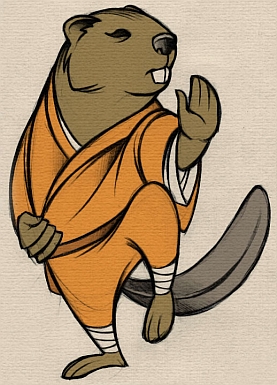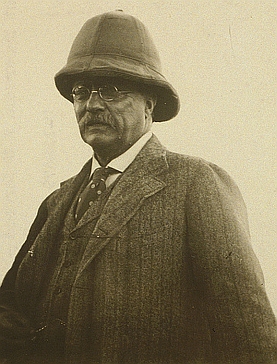Day 9: Favorite Characters I’ve Not Played
I guess in a way I’m cheating a bit today because I’m not writing specifically about D&D. I do have two characters that I’ve always wanted to play, but have never gotten to. Neither were made for D&D, but they were made for games that would almost certainly not exist had D&D not made the shift to the d20 System with 3E. The first character is Shaolin Beaver for Mutants & Masterminds. The other is William Robert Kelly for True20 Adventure Roleplaying. Enjoy!

Shaolin Beaver
Quote: “Shaolin is the wine of peacefulness, not the vinegar of hostility.”
Concept: Anthropomorphised beaver kung-fu master
Occupation: Sifu
Real Name: Edward
Legal Status: Naturalized citizen of the United States of America with no criminal record
Identity: Public
Place of Birth: Forests of the North American Pacific Northwest
Marital Status: Widowed
Living Relatives: None known
Height: 3 ft. 7 in.
Weight: 58 lb.
Eyes: Dark brown
Fur: Golden brown with reddish highlights
Motivation: Goodness, quest
Complications: Enemy, honor, obsession
Background: Edward is perhaps the last member of a sentient race of humanoid beavers native to the North American Pacific Northwest. Habitat destruction, poaching, and an outbreak of deadly beaver flu have apparently destroyed this once noble people. Edward himself was captured by unscrupulous xenocollectors shortly after he buried his wife Margaret, who had died from the beaver flu.
A lapse in security let Edward escape from the xenocollectors, but his absence did not long go undetected. Pursued through the forests near Mount Ranier in Washington, Edward suffered a gunshot wound and fell several yards into a shallow stream. Injured and terrified, he still managed to elude capture, stumbling into the campsite of Mr. and Mrs. Ethan Stone of Seattle.
The Stones took Edward back to their home and nursed him to health. As fate would have it, Ethan was a student of Deng Ming Dao, a Chinese expatriate and one of the last true Shaolin masters. Edward and Deng Ming Dao became fast friends, and Edward evidenced great natural talent for the study of kung-fu.
After a long period of martial arts schooling, a sense of wanderlust possessed Edward. He donned the traditional orange robes of a Shaolin monk and traveled the land, earning his keep through a variety of odd jobs and having adventures. Throughout his travels, he remains ever-vigilant for rumors about others of his kind.
STR 10 (+0); DEX 20 (+5); CON 16 (+3); INT 11 (+0); WIS 18 (+4); CHA 11 (+0)
TOU +8/+3*; FORT +8; REF +15; WILL +10; INIT +9; KNOCKBACK -3/+0*
* If flat-footed
MELEE +15; RANGE +8; GRAPPLE +11; DAMAGE +5 Strike (crit 18-20); DEFENSE +12
Skills: Acrobatics 12 (+17), Concentration 9 (+13), Craft (structural) 4 (+4), Escape Artist 10 (+15), Knowledge (theology and philosophy) 5 (+5), Notice 6 (+10), Search 6 (+6), Sense Motive 12 (+16), Stealth 4 (+13)
Feats: Acrobatic Bluff, Assessment, Attack Focus 9 (melee), Attack Focus 2 (ranged), Blind-Fight, Defensive Attack, Defensive Roll 5, Evasion, Grappling Finesse, Improved Critical 2 (Strike), Improved Disarm, Improved Initiative, Improved Sunder, Improved Trip, Power Attack, Prone Fighting, Redirect, Set-Up, Stunning Attack, Takedown Attack 2, Trance, Ultimate Skill (Sense Motive), Uncanny Dodge (Auditory)
Powers:
* Shrinking 4 (Size: Small; Power Feat: Innate; Flaw: Permanent [-1])
* Strike 5
* Swimming 2 (Speed: 5 MPH)

William Robert Kelly
Quote: “Well, I’ll be super-amalgamated!”
Profession: Archaeologist
Legal Status: Citizen of the United States with no criminal record
Place of Birth: Philadelphia, Pennsylvania
Marital Status: Single
Height: 5 ft. 7 in.
Weight: 145 lb.
Description: William is slightly built but healthy. His dark brown hair is flecked through with gray. His clothes are usually rumpled. His pith helmet is ubiquitous.
Background: William Robert Kelly was born in Philadelphia, Pennsylvania, on November 2, 1899. From an early age, he evidenced both an extraordinary memory and intelligence. William absorbed information like a dry sponge soaks up water. He rapidly progressed through the education system into university well ahead of his peers.
Today, William is one of the most brilliant minds of his generation. He earned his Ph.D.s in archaeology and botany from Fordham University, his Doctorate of Sacred Theology from the Istituto Pontificio di S. Anselmo (an honor seldom bestowed upon a layperson), and (most recently) his Doctor of Medicine from Harvard University all before his thirtieth birthday. William is also an astonishing polyglot who is fluently reads, speaks, and writes ten languages (including his native English).
After Harvard Medical School in 1929, William traveled to Canton City, China, as part of a Catholic missionary group. There he helped establish and staff a hospital, and also trained Chinese volunteers to act as nurses and orderlies. In his spare time, he became friendly with British archaeologists excavating Nanyue Palace and eventually started to help with the dig and item classifications.
While working the Nanyue Palace site, William befriended Bai Mu Dan, one of the Chinese workers and a master of Shequan, or “snake fist” kung fu. William and Bai spent many late night hours discussing the history of the Wudang Mountain Taoist masters and drinking large quantities of Du Kang. William even learned the rudiments of Shequan from Bai, making William probably the first Westerner to be taught this form of kung fu.
Starting in 1931, the disruptions caused by conflicts between Chinese nationalists, the revolutionary Chinese Socialist Republic, and the Japanese annexation of Manchuria made Canton City too dangerous for Westerners. William left China and the Catholic missionary group, and he traveled west to India with Bai and the British archaeologists who’d become William’s colleagues.
William became involved with a dig site in northern India centered on the tombs of several late Gupta dynasty kings. William noticed a peculiar similarity between motifs and Sanskrit engravings found in India with motifs and Cantonese writings found at Nanyue Palace. Local Indian folktales also bore striking similarities with Bai’s tales of the Wudang Mountain Taoist masters.
After several months in India, William said good-bye to his friends and traveled farther to the west through Persia and on into Egypt. Everywhere he went, he found variations of the same motifs and legends, all centered around an eternal struggle between heroes and the agents of a horrible snake demon. While the snake demon’s name changed from language to language, they all were a variation on idiomatic expressions roughly translated into English as, “It Who Envenoms Darkness.”
William became convinced that all of these various legends and artifacts had a common origin in eastern central Europe among the Indo-Europeans. The oldest indications of the snake cult were found in the Indus River Valley, where the creature was known by the Sanskrit word transliterated as Yig. William also has good reason to believe that the disparate snake demon cults found from North Africa to Southern China still exist today as potentially dangerous secret societies.
After five years of travel and research, William has recently returned to the United States to compile his findings for eventual publication. In his spare time, he teaches as an adjunct professor of archaeology and paleobotany at Harvard University.
Role: Expert 3
Conviction: 4
Virtue: Intrepid
Vice: Acerbic
STR +0; DEX +1; CON +1; INT +4; WIS +0; CHA +0
TOU +2; FORT +2; REF +2; WILL +3
INIT +1; DODGE +1; PARRY +0; BASE ATTK +2
MELEE +3; RANGED +3; DEFENSE +7
WEALTH +12; REPUTATION +1
Languages: Aramaic, Cantonese, English (native), French, German, Greek, Hebrew, Italian, Latin, Sanskrit
Skills: Craft (mechanics) +10, Disable Device* +10, Knowledge (history) +10, Knowledge (life sciences) +10, Knowledge (supernatural) +10, Knowledge (theology and philosophy) +10, Medicine* +6, Notice +6, Ride* +7, Search* +10, Sense Motive +6, Survival +6
Feats: Canny Dodge, Defensive Roll, Eidetic Memory, Improved Critical (unarmed strike), Improved Unarmed Strike, Seize Initiative, Skill Mastery (* skills)
Special Equipment:
Masterwork “Snake Gloves”
* These leather gauntlets are reinforced with knuckle studs and iron fingertip spikes grant a +1 bonus to attack rolls and damage with unarmed strikes.
Masterwork “Hypo-Darts”
* William designed these special darts. When thrown properly, a hypo-dart injects a spring-loaded needle that delivers a powerful dose of narcotics. They are well-balanced (granting a +1 attack roll bonus). The drug dose induces fatigue (Fort save DC 15). A hypo-dart cannot pierce medium or heavy armor. A hypo-dart has a range increment of 20 ft.
Masterwork “Bang Stick”
* William also designed this special walking stick. When the handle is twisted to the “on” position (a move action), the business end becomes capable of discharging a modified shotgun slug as a melee attack (+6 damage bonus). Reloading the “bang stick” requires a move action. William enjoys a +1 attack roll bonus with this weapon.

Leave a Reply